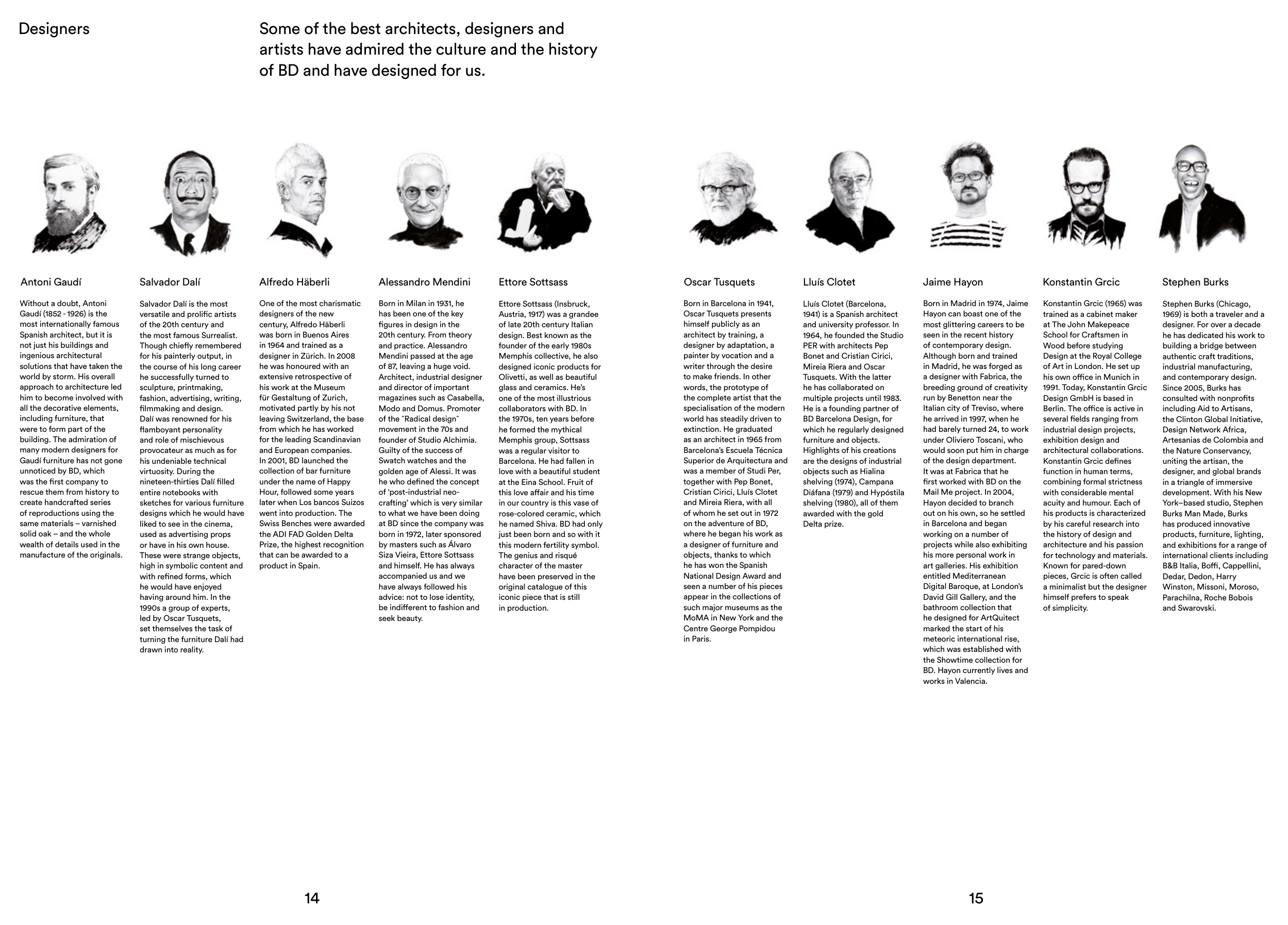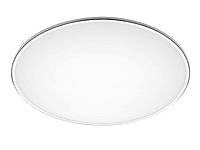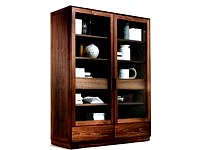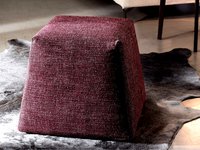Salvador Dalí
Lluís Clotet
Ettore Sottsass
Stephen Burks
Without a doubt, Antoni
Gaudí (1852 - 1926) is the
most internationally famous
Spanish architect, but it is
not just his buildings and
ingenious architectural
solutions that have taken the
world by storm. His overall
approach to architecture led
him to become involved with
all the decorative elements,
including furniture, that
were to form part of the
building. The admiration of
many modern designers for
Gaudí furniture has not gone
unnoticed by BD, which
was the first company to
rescue them from history to
create handcrafted series
of reproductions using the
same materials – varnished
solid oak – and the whole
wealth of details used in the
manufacture of the originals.
Born in Barcelona in 1941,
Oscar Tusquets presents
himself publicly as an
architect by training, a
designer by adaptation, a
painter by vocation and a
writer through the desire
to make friends. In other
words, the prototype of
the complete artist that the
specialisation of the modern
world has steadily driven to
extinction. He graduated
as an architect in 1965 from
Barcelona’s Escuela Técnica
Superior de Arquitectura and
was a member of Studi Per,
together with Pep Bonet,
Cristian Cirici, Lluís Clotet
and Mireia Riera, with all
of whom he set out in 1972
on the adventure of BD,
where he began his work as
a designer of furniture and
objects, thanks to which
he has won the Spanish
National Design Award and
seen a number of his pieces
appear in the collections of
such major museums as the
MoMA in New York and the
Centre George Pompidou
in Paris.
One of the most charismatic
designers of the new
century, Alfredo Häberli
was born in Buenos Aires
in 1964 and trained as a
designer in Zürich. In 2008
he was honoured with an
extensive retrospective of
his work at the Museum
für Gestaltung of Zurich,
motivated partly by his not
leaving Switzerland, the base
from which he has worked
for the leading Scandinavian
and European companies.
In 2001, BD launched the
collection of bar furniture
under the name of Happy
Hour, followed some years
later when Los bancos Suizos
went into production. The
Swiss Benches were awarded
the ADI FAD Golden Delta
Prize, the highest recognition
that can be awarded to a
product in Spain.
Born in Madrid in 1974, Jaime
Hayon can boast one of the
most glittering careers to be
seen in the recent history
of contemporary design.
Although born and trained
in Madrid, he was forged as
a designer with Fabrica, the
breeding ground of creativity
run by Benetton near the
Italian city of Treviso, where
he arrived in 1997, when he
had barely turned 24, to work
under Oliviero Toscani, who
would soon put him in charge
of the design department.
It was at Fabrica that he
first worked with BD on the
Mail Me project. In 2004,
Hayon decided to branch
out on his own, so he settled
in Barcelona and began
working on a number of
projects while also exhibiting
his more personal work in
art galleries. His exhibition
entitled Mediterranean
Digital Baroque, at London’s
David Gill Gallery, and the
bathroom collection that
he designed for ArtQuitect
marked the start of his
meteoric international rise,
which was established with
the Showtime collection for
BD. Hayon currently lives and
works in Valencia.
Born in Milan in 1931, he
has been one of the key
figures in design in the
20th century. From theory
and practice. Alessandro
Mendini passed at the age
of 87, leaving a huge void.
Architect, industrial designer
and director of important
magazines such as Casabella,
Modo and Domus. Promoter
of the ˝Radical design˝
movement in the 70s and
founder of Studio Alchimia.
Guilty of the success of
Swatch watches and the
golden age of Alessi. It was
he who defined the concept
of ‘post-industrial neo-
crafting’ which is very similar
to what we have been doing
at BD since the company was
born in 1972, later sponsored
by masters such as Álvaro
Siza Vieira, Ettore Sottsass
and himself. He has always
accompanied us and we
have always followed his
advice: not to lose identity,
be indifferent to fashion and
seek beauty.
Konstantin Grcic (1965) was
trained as a cabinet maker
at The John Makepeace
School for Craftsmen in
Wood before studying
Design at the Royal College
of Art in London. He set up
his own office in Munich in
1991. Today, Konstantin Grcic
Design GmbH is based in
Berlin. The office is active in
several fields ranging from
industrial design projects,
exhibition design and
architectural collaborations.
Konstantin Grcic defines
function in human terms,
combining formal strictness
with considerable mental
acuity and humour. Each of
his products is characterized
by his careful research into
the history of design and
architecture and his passion
for technology and materials.
Known for pared-down
pieces, Grcic is often called
a minimalist but the designer
himself prefers to speak
of simplicity.
Salvador Dalí is the most
versatile and prolific artists
of the 20th century and
the most famous Surrealist.
Though chiefly remembered
for his painterly output, in
the course of his long career
he successfully turned to
sculpture, printmaking,
fashion, advertising, writing,
filmmaking and design.
Dalí was renowned for his
flamboyant personality
and role of mischievous
provocateur as much as for
his undeniable technical
virtuosity. During the
nineteen-thirties Dalí filled
entire notebooks with
sketches for various furniture
designs which he would have
liked to see in the cinema,
used as advertising props
or have in his own house.
These were strange objects,
high in symbolic content and
with refined forms, which
he would have enjoyed
having around him. In the
1990s a group of experts,
led by Oscar Tusquets,
set themselves the task of
turning the furniture Dalí had
drawn into reality.
Lluís Clotet (Barcelona,
1941) is a Spanish architect
and university professor. In
1964, he founded the Studio
PER with architects Pep
Bonet and Cristian Cirici,
Mireia Riera and Oscar
Tusquets. With the latter
he has collaborated on
multiple projects until 1983.
He is a founding partner of
BD Barcelona Design, for
which he regularly designed
furniture and objects.
Highlights of his creations
are the designs of industrial
objects such as Hialina
shelving (1974), Campana
Diáfana (1979) and Hypóstila
shelving (1980), all of them
awarded with the gold
Delta prize.
Ettore Sottsass (Insbruck,
Austria, 1917) was a grandee
of late 20th century Italian
design. Best known as the
founder of the early 1980s
Memphis collective, he also
designed iconic products for
Olivetti, as well as beautiful
glass and ceramics. He’s
one of the most illustrious
collaborators with BD. In
the 1970s, ten years before
he formed the mythical
Memphis group, Sottsass
was a regular visitor to
Barcelona. He had fallen in
love with a beautiful student
at the Eina School. Fruit of
this love affair and his time
in our country is this vase of
rose-colored ceramic, which
he named Shiva. BD had only
just been born and so with it
this modern fertility symbol.
The genius and risqué
character of the master
have been preserved in the
original catalogue of this
iconic piece that is still
in production.
Stephen Burks (Chicago,
1969) is both a traveler and a
designer. For over a decade
he has dedicated his work to
building a bridge between
authentic craft traditions,
industrial manufacturing,
and contemporary design.
Since 2005, Burks has
consulted with nonprofits
including Aid to Artisans,
the Clinton Global Initiative,
Design Network Africa,
Artesanias de Colombia and
the Nature Conservancy,
uniting the artisan, the
designer, and global brands
in a triangle of immersive
development. With his New
York–based studio, Stephen
Burks Man Made, Burks
has produced innovative
products, furniture, lighting,
and exhibitions for a range of
international clients including
B&B Italia, Boffi, Cappellini,
Dedar, Dedon, Harry
Winston, Missoni, Moroso,
Parachilna, Roche Bobois
and Swarovski.
Antoni Gaudí
Oscar Tusquets
Alfredo Häberli
Jaime Hayon
Alessandro Mendini
Konstantin Grcic
Some of the best architects, designers and
artists have admired the culture and the history
of BD and have designed for us.
Designers
15
14







